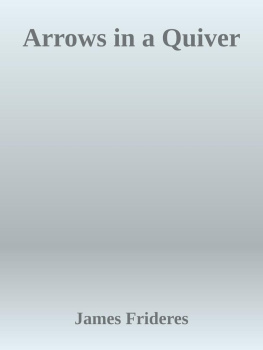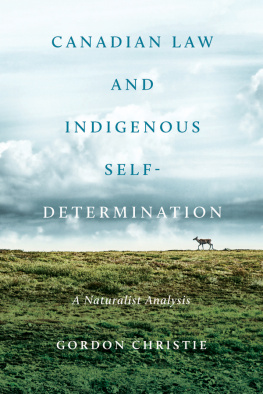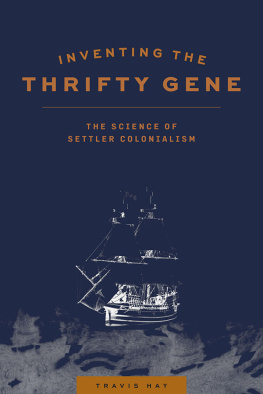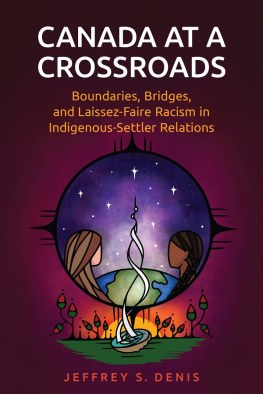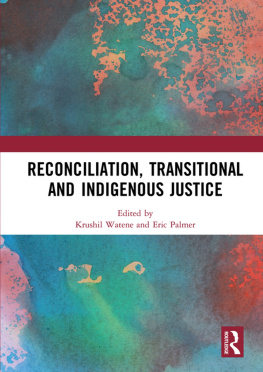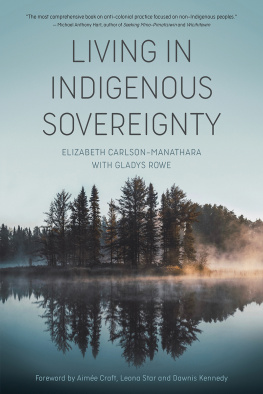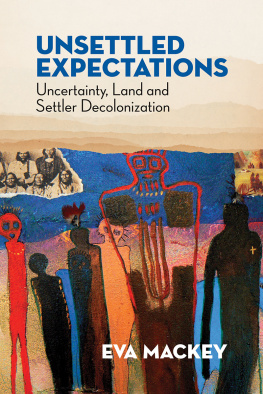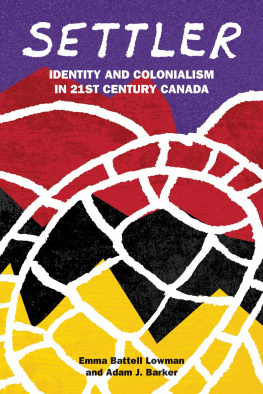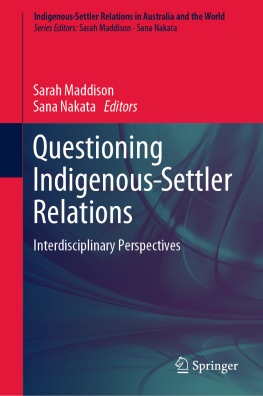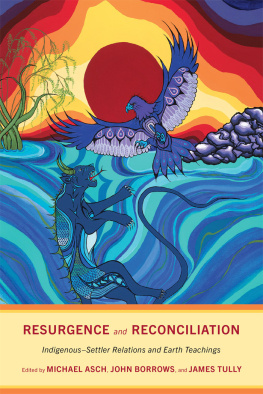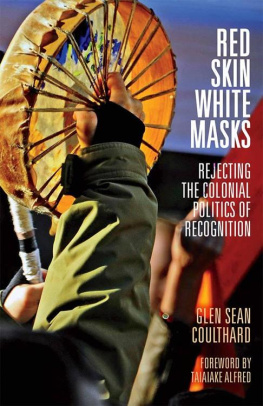Advance Praise for
Arrows in a Quiver
A comprehensive and excellent book.
Cash Ahenakew, Professor of Education,
University of British Columbia
A useful introduction to Indigenous issues, especially for post-secondary students in Canada. Jonathan Dewar, co-editor of Cultivating Canada:
Reconciliation through the Lens of Cultural Diversity
Focusing on the many relationships between Indigenous peoples and the Crown, James Frideres shows how pervasive colonialism has been on Indigenous Places and Canadian legal system since the first encounters, and into the age of Reconciliation. It is a must-read for non-Indigenous settlers in Canada, and especially for government politicians and lawyers.
David McNab, co-author of Canadas First Nations: A History of Founding Peoples from Earliest Times
Arrows in a Quiver makes a serious advance in state-of-the-art research. Jim Frideres has taken the many disparateand sometimes conflictingcommentaries on decolonization and situated them in their historical context as shaped by government action/inaction. After having established this historical context, he goes a step further and provides insight into what the path to reconciliation, as called for by the Truth and Reconciliation Commission, necessitates. Situating the historical, political, and social contexts provides understanding into what decolonization and a devolution of governmental power may entail, an understanding which is critical if reconciliation is to be embraced by Indigenous and non-Indigenous Canadians alike.
Cathy Prowse, Professor of Sociology & Anthropology, Mount Royal University
Arrows in a Quiver is a remarkable book that is essential reading for all Canadians who want to understand the roots of the ongoing and seemingly intractable relationship of Indigenous Peoples and the state. The author, James Frideres, has devoted his professional life to analysing this critical topic from multiple perspectives and offers crucial insights for possible ways forward.
Arthur J. Ray, oc , frsc , Professor Emeritus of History, University of British Columbia, and author of Aboriginal Rights Claims and the Making and Remaking of History
Arrows
in a Quiver
Indigenous-Canadian Relations from Contact to the Courts
james frideres
2019 University of Regina Press
All rights reserved. No part of this work covered by the copyrights hereon may be reproduced or used in any form or by any means graphic, electronic, or mechanical without the prior written permission of the publisher. Any request for photocopying, recording, taping or placement in information storage and retrieval systems of any sort shall be directed in writing to Access Copyright.
Printed and bound in Canada at Friesens. The text of this book is printed on 100% post-consumer recycled paper with earth-friendly vegetable-based inks.
Cover design: Duncan Campbell, University of Regina Press
Text design: John van der Woude, jvdw Designs
Copy editor: Dallas Harrison
Proofreader: Kristine Douaud
Indexer: Jenn Harris
Cover art: "Portrait of a One Percenter - Transformation," 2015, private collection, by Lawrence Paul Yuxweliptun. Photo by Heffel Fine Art Auction House.
Library and Archives Canada Cataloguing in Publication
Title: Arrows in a quiver : Indigenous-Canadian relations from contact to the courts / James Frideres.
Names: Frideres, James S., 1943- author.
Description: Includes bibliographical references and index.
Identifiers: Canadiana (print) 20190157615 | Canadiana (ebook) 20190157674 |
isbn 9780889776814 (hardcover) | isbn 9780889776784 (softcover) |
isbn 9780889776807 ( html ) | isbn 9780889776791 ( pdf )
Subjects: csh : Native peoplesCanadaGovernment relations. | csh : Native peoplesCanadaPolitics and government. | csh : Native peoplesLegal status, laws, etc.Canada. | csh : Native peoplesCivil rightsCanada. | csh : Native peoplesCanadaSocial conditions. | lcsh : CanadaRace relations. | lcsh : CanadaEthnic relations. | lcsh : DecolonizationCanada.
Classification: lcc E92 .F75 2019 | ddc 305.897/071dc23
10 9 8 7 6 5 4 3 2 1
University of Regina Press, University of Regina
Regina, Saskatchewan, Canada, s4s 0a2
tel: (306) 585-4758 fax: (306) 585-4699
web: www.uofrpress.ca
We acknowledge the support of the Canada Council for the Arts for our publishing program. We acknowledge the financial support of the Government of Canada. / Nous reconnaissons lappui financier du gouvernement du Canada. This publication was made possible with support from Creative Saskatchewans Book Publishing Production Grant Program.
Contents
Maps and Tables
Authors Note
Preface
Terminology
Timeline of Significant Historical Events
Introduction
Chapter 1. Indigeneity in Canada
Chapter 2. Relations between Indigenous and Non-Indigenous People
Chapter 3. Keeping the Land
Chapter 4. Indigenous Treaties, Mtis Scrip, and the Manitoba Act
Chapter 5. Aboriginal Rights
Chapter 6. The Role of the Courts
Chapter 7. The Social Organizations of Indigenous Peoples
Conclusion. Reconciliation and Resilience in the Twenty-First Century
Acknowledgements
References
About the Author
Maps and Tables
map 1. Tribal Distribution in Canada at Time of Contact
map 2. Inuit Regional Districts, 2000
map 3. Mtis Areas of Settlement and Hunting, Twentieth Century
map 4. Historical Treaties
map 5. Modern Comprehensive Claims
Table 1.1. Indigenous Identity Population, Canada, 2016
Table 1.2 . Distribution and Percentage of Population Reporting an Indigenous Identity in the Population, Canada, Provinces, and Territories, 2016
Table 4.1 . National Summary of Specific Claims (19732017)
Authors Note
When settlers entered what is now Canada, many Indigenous peoples were eliminated by disease, starvation and outright genocide by the state. Those who survived were relegated to the margins of society and had their families, health, spirituality, land, and language taken away or destroyed. Over the years, the state continued these attacks on first peoples.
But now Indigenous peoples and communities are resisting. They are plugging into global and domestic Indigenous advocacy networks, organizing social movements and activist organizations, and participating in the legal and political spheres of Canadian society to combat colonialism and the institutions that have promulgated the marginalization of Indigenous peoples. Community economic development initiatives are emerging from their grassroots, and Indigenous people are taking back control of the education of their young people and preserving their traditional languages.
The emergence of multiple ways in which to resist colonial ideology and action has given Indigenous people an arsenal of arrows to use to confront the state use of genocide, institutional racism, and the promotion of assimilation. These arrows are allowing Indigenous peoples to reclaim what they lost during colonization, re-establish their voice in Canadian society, and achieve equality and justice.

